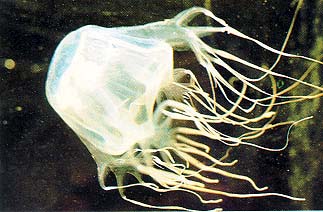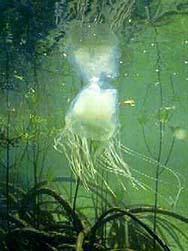Box jellyfish, Boxfish, Deadlysea wasp
| Box jellyfish, Boxfish, Deadly sea wasp Chironex fleckeri Box jellyfish is considered the most venomous marine creature. It can kill more people than stonefish, sharks and crocodiles combined. |
Chironex may be found in shallow water at the edge of beaches in Northern Australian and Indo-Pacific region. Adult jellyfish spawn at river mouths in late summer. The fertilized eggs attach themselves to rocks in the form of tiny polyps. In spring, these polyps develop into small jellyfish that migrate downstream, especially with rains. They feed on shrimps and often frequent beaches that are attractive to humans. These animals have chosen a strategy of passive hunting- they simply wait for the prey to bump into their tentacles. Since a struggling shrimp can tear a young jellyfish, it needs to be killed instantly with a very strong poison.
| |||
| In each corner of the box-shaped bell, often as large as a basketball, there is a bundle of ten to sixty stinging tentacles, which can extend for up to 2 m. | |||
The body of a sea wasp can weight as much as 2 kg. The tentacles are armed with up to 5,000 nematocysts, or stinging cells. Certain chemicals on the surface of fish, shellfish and humans activate these. Contact with only 3 m of tentacles may be fatal for an adult. There are many (about 70) reported deaths that have occurred in northern Australia between November and April.
| ||
| According to recent discoveries, the box jellyfish is able to see through four eyes, one at the center of each side of the bell. It is not known how the animal processes the visual information without a brain. However, it avoids even the tiniest objects. Box jellyfish probably try to avoid humans as well; stings usually occur when people bump into them. An interesting fact is that turtles are not affected by their sting and eat them. |
Another specie, Chiroplasmus quadrigatus, is generally less common than Chironex fleckeri, though it may prevail in some places. It is smaller, with slimmer tentacles but very much resembles the sea wasp. The box jellyfish is, however, the most lethal member of its family.Symptoms and first aid
The venom of box jellyfish has cardiotoxic, neurotoxic and highly dermatonecrotic components. When injected, it is rapidly absorbed into the circulation. The pain is excruciating; the tentacles become sticky and adhere tightly to the skin. Any attempt at removal of the tentacles while they are still active may worsen the sting and lead to great injuries. Severe stings result in necrosis of the affected skin area. If treatment is not given, the pain may last for weeks and often stings leave significant scars.Domestic vinegar (never methylated spirits) should be poured over the adhering tentacles to inactivate nematocysts as quickly as possible. When the tentacles become inactive, they can be safely removed. (The application of vinegar is not intended to decrease pain or diminish the effects of the venom; it will only stop further discharging of nematocysts). In case of respiratory or
cardiovascular failure, basic life support such as artificial respiration and cardiac massage is necessary. Where antivenom is not available, pressure-immobilization of the limbs may be used after inactivation of nematocysts while the patient is transported to hospital.Indications for antivenom include cardiorespiratory arrest or arrythmias, difficulty with breading, speech or swallowing and extensive skin lesions. Assisted ventilation and analgesics may be needed. Early administration of antivenom will reduce pain
and decrease scarring. Local pain is usually best treated with ice packs.


